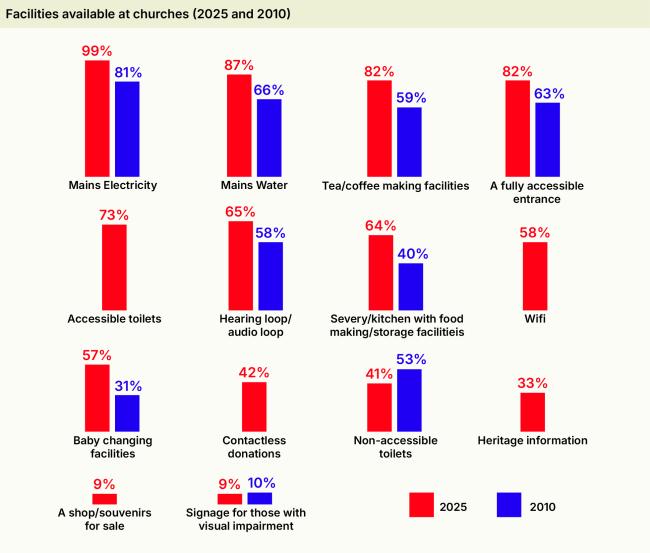
Facilities: fit for today’s communities
Since 2010, thousands of churches have taken significant steps to improve accessibility and usability. What emerges from the National Churches Survey is how in the last 15 years, churches have been working hard to make their spaces practical as well as spiritual, and open to as many as possible. Running water, modern heating, accessible toilets, and safe kitchens are not luxuries, but the minimum expected by people who use these places for worship, community meals, youth groups, or local events.
In recent years, the addition of Wifi has transformed how some churches open their doors, allowing them to connect with younger generations, host hybrid events, and support everything from language workshops to online learning.
Progress has often depended on the dedication of volunteers and the availability of funds. But these changes are not just compliance measures, they are about keeping buildings welcoming and relevant for the communities that use them.
The bar chart below compares 2010 to 2025 responses to questions about church facilities.

Everyday essentials
Everyday facilities are now significantly more widespread than in 2010. While the National Churches Survey shows there is near-universal access to mains electricity (99%), there are gaps between rural and urban churches in the overall provision of everyday essentials, with only 76% of rural churches being supplied by mains water compared to 99% in urban areas and 98% in suburban areas.
Hospitality remains a defining feature of churches around the country. 82% of churches have tea–making facilities and almost two thirds (64%) have a kitchen or servery, though again rural churches report lower provision (46%) compared to urban ones (85%) and suburban churches (79%). These kitchens are not just for after-service refreshments – they make possible community meals, toddler groups, managing foodbank distribution, and countless other gatherings where people find companionship and support. Also, baby changing facilities are now present in nearly six in ten (57%) churches, making them more welcoming for families.
Some churches have gone further, adding shops (9%) and heritage information points (33%). While these figures remain relatively low, they reveal an entrepreneurial spirit and a desire to keep buildings relevant – and a possible future direction for others to follow.

Running water revolutionises how Welsh church can support its community
No longer will visitors at St Mary the Virgin church in Risca, Monmouthshire, have to be escorted across a busy road and up a steep path some 70 metres away to a neighbouring hall to use the toilets.
After 171 years the Grade II*listed church got running water for the first time. St Mary’s fundraised and submitted grant applications to pay for an accessible toilet and a kitchen servery area to be installed at the church.
The team at St Mary are ready and excited for the community to use the space more; these changes will enable refreshments to be served as part of meetings and groups and ensure that the building is welcoming to everyone.
“St Mary’s, built in 1853, is the latest in a long line of churches that has occupied this site since the 13th
century and settlements going back to Roman times,” says Janet Jones, Churchwarden at St Mary’s.
“These churches have seen the growth of Risca from a small valley rural community, through the Industrial Revolution to the urban residential town of today. Providing these new facilities will massively improve our ability to reach out into our local community and hopefully offer better support.”
The past fifteen years have seen a quiet transformation in how churches connect. Digital infrastructure was not measured in 2010, but in this Survey almost six in ten churches (58%) report having Wifi. Of these, two–thirds of urban churches (83%) and 73% of suburban ones are connected. In cities and towns, Wifi is now almost as important as heating or lighting, enabling livestreamed services, hybrid worship, online bookings and digital giving. In rural areas however, only 37% say they have Wifi, and this lack of connectivity risks making churches feel less accessible.
Digital access is not just about worship, but about sustainability and inclusion. More than four in ten churches (42%) now accept contactless donations, and many use Wifi to support online ticketing, concerts, cafés or community markets. Connectivity also strengthens secular use: groups can run presentations, courses and film nights; choirs and youth clubs can share events online; local charities can base activities in well-connected spaces. Reliable internet allows churches to serve as both heritage landmarks and modern hubs, bridging the needs of today’s communities with the stories of the past, and making them indispensable to civic as well as spiritual life.
Continue reading
The next section is 'Opening doors: accessibility as hospitality'.
